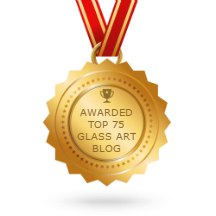One of my galleries, Backstreet Gallery, holds special exhibits every so often and this time we were asked to create something showing warmth for Valentine’s Day. I didn’t want just your typical heart and came upon a graphic showing hands holding a heart.

Of course, I am always behind and this time was no exception. And when I am behind and in a hurry, I don’t always think things through. I had carefully calculated how many days I would need in the kiln and made time three days before the deadline to get the first phase done. What I didn’t take into consideration was a pending big storm which knocked out power. I knew it was coming! What was I thinking starting the kiln!
We lost power just as the kiln was ramping up and was approximately 1265 degrees F. This meant no annealing on the way down to room temperature. After we finally got power 2.5 days later, I decided to fire again hoping that going through an anneal cycle this time would be okay and the piece would not crack.
It cracked into 3 large pieces. I could not say for sure though that the crack was caused by the loss of power. My lay-up was a single sheet of 3mm white, on which I then placed the red heart and the black hands were overlapping the red heart. So some areas were 3mm and some areas were 9 mm. I took it slowly on the way up and then annealed it for 3 hours. The crack definitely happened on the way down. I have had difficulties before when the base layer was a single 3mm sheet.
Therefore take two involved first firing a base of 3mm white and 2mm clear. Then I added the red heart and the overlapping black hands. This time I went from 5mm to 11mm. This time I went even slower on the way up, and again annealed for 3 hours. No crack this time! I like the sturdier base and my piece is finally at the Gallery albeit 2 weeks late.
Next time I will pay attention when I get a weather alert! Happy Fusing!








